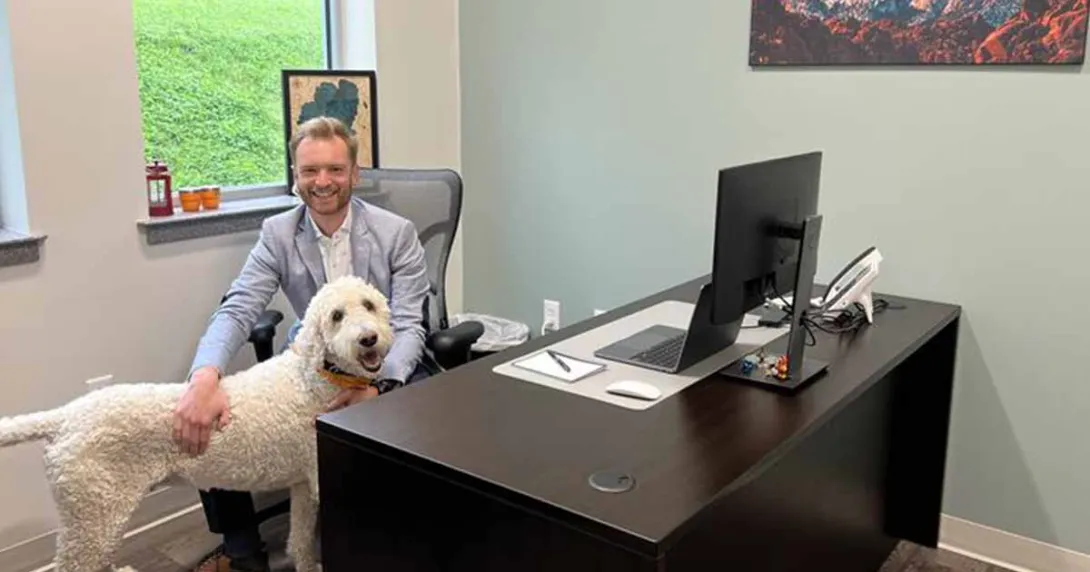
Odie, and his best friend Jessie Storey, director of IT and compliance at Mountain Laurel Medical Center
Photo: Jessie Storey
Mountain Laurel Medical Center is a federally qualified health center serving Maryland and West Virginia and is committed to implementing the patient-centered medical home model. With 25 providers and multiple locations, it provides essential healthcare services – including integrated behavioral health – to diverse, rural and aging communities.
THE CHALLENGE
Community health centers are vital hubs where anyone, regardless of insurance status, can access high-quality, personalized care. Mountain Laurel emphasizes holistic health and preventive care, which means it’s not just tackling immediate health issues but also working to educate patients and improve the overall well-being of the communities.
That said, being an FQHC comes with its own set of challenges.
"We have to navigate a maze of value-based contracts, additional reporting requirements, staffing challenges and operational hurdles," said Jessie Storey, director of IT and compliance at Mountain Laurel. "It takes careful management and strategic planning to keep everything running smoothly.
"We were really feeling the strain from our old on-premises EHR system," he continued. "It created a ton of operational challenges that made it tough for us to grow and scale while providing the high-quality care our patients deserve."
The system was cumbersome and required far more manual upkeep than Mountain Laurel could handle, which prevented the FQHC from moving into new communities. Using it felt like a chore – it was laborious and time-consuming, and it didn't give staff the visibility they needed into revenue cycle data or other key business insights.
"To make matters worse, with four locations spread out 60 to 90 miles apart, managing and updating our IT infrastructure was complicated and painful," Storey explained. "It took up a lot of time and resources, and we often faced downtime, which added to the stress.
"We needed a system that was flexible and modern, one that offered better functionality and interoperability for our clinicians and staff," he added. "We wanted something that would streamline the patient's experience and provide robust insights to enhance our operational efficiency. Most importantly, we needed a system that would support our growth while enabling us to deliver even better patient care without overburdening our team."
PROPOSAL
Mountain Laurel looked to move to an EHR system that would better support its business needs, including providing operational insights and clinical insights right at the point of care. This would empower clinics to take on more patients while allowing providers to focus on caring for patients. The FQHC turned to EHR vendor athenahealth.
"In looking at athenaOne, a big plus was the analytics it provides to monitor performance metrics, track our revenue cycle management and optimize workflows – all of which would support our strategic growth plans," Storey said. "Visibility into both clinical and operational data would help us pinpoint areas that needed improvement.
"That said, we were wary of the potential disruption that digital transformation could bring, so we needed a vendor that could help us make the transition as smoothly and efficiently as possible," he continued.
The vendor assured Mountain Laurel the cloud-based suite of EHR, practice management and revenue cycle management systems and patient engagement tools would allow for a straightforward switch and would help the FQHC transform its operational efficiency, improve patient care, and support sustainable growth without the headache of a complicated transition.
"One of the standout features of athenaOne was its enhanced interoperability that could enable different systems and applications to share and use data seamlessly," Storey said. "This is a breakthrough for improving care coordination and cutting down on delays in sharing information, and something that we just did not have access to previously.
"Another thing that really excited us about the technology was the prospect for it to automate a lot of the administrative tasks we were bogged down with, like scheduling, billing and documentation processes," he continued. "This would significantly lighten the load on our staff. Plus, with real-time access to patient data and insights, our providers could make quick, informed decisions."
Finally, as Mountain Laurel expands to see more patients, the new systems would easily scale to meet those demands without sacrificing the quality of care provided, he added. The platform includes modern patient engagement tools, like online appointment scheduling, reminders and secure messaging, which can enhance communication and boost patient satisfaction and retention, he said.
"So, after careful consideration, we chose athenaOne to help us tackle our operational challenges, continue providing high-quality care and set us up for sustainable growth," he said.
MEETING THE CHALLENGE
The implementation process for the new technology was quick and efficient, which really helped ease any worries staff had about potential disruptions, Storey reported. The supportive and speedy onboarding quickly put those concerns to rest, he said.
"We were particularly impressed with the athenahealth support teams, who worked with us throughout the implementation," he recalled. "Their assistance made the migration smooth and kept interruptions to a minimum, allowing us to hit the ground running and work together to optimize every click that we make.
"What really caught our attention was how the athenaOne network gave us immediate access to state registries, making interoperability a breeze without the headaches of a complicated transition," he continued. "In the past, something as straightforward as setting up an interface with a state registry could take anywhere from six months to a year-and-a-half to get it right. But with the new technology, it felt like flipping a switch on day one."
Also, patients often have records not only at various care sites, but also at pharmacies, and with the new system, providers can see the entirety of a patient's chart and history in one place, with relevant and up-to-date information at their fingertips, he added.
"The primary users of the system are our healthcare providers and administrative staff, who find it incredibly helpful for streamlining various processes," Storey noted. "The automation significantly lightens the load on our teams, allowing us to focus more on patient care. This includes documenting with Suki AI, an ambient AI assistant, through an athenahealth Marketplace integration.
"Using ambient listening, our providers are seeing productivity improvements and gaining efficiency, letting them go home on time at the end of the day," he continued. "Ambient scribing also helps reduce the cognitive load of typing or writing shorthand notes for each visit, and grants providers more time to focus more fully on their patients, which patients really appreciate."
Providers also use another athenahealth Marketplace partner, Navina, that allows for evidence-based risk adjustment and automated quality care gaps management, resulting in improved patient outcomes, physician satisfaction and value-based performance, he added.
"For our administrative staff, the reporting and analytics capabilities of the new technology provide us with actionable insights," Storey explained. "We can easily monitor performance metrics and track our revenue cycle management, which helps us identify areas for improvement.
"I personally find the system’s Data View to be invaluable," he noted. "It enables our finance and quality teams to dig into the data, automate reports and keep an eye on our value-based contracts. This way, we can spend less time searching for information and more time analyzing it, which makes it easier for us to act on insights quickly."
And athenaOne's automatic updates ensure staff always have access to the latest features and security enhancements without the need to spend time and money on GAP analysis, custom development and retraining staff every few months, he added. This lets staff focus on providing quality patient care while also staying current with regulatory changes and compliance requirements, he said.
RESULTS
Overall, the combination of the system’s user-friendly interface, intuitive workflows, robust integration capabilities and powerful analytics tools has transformed how Mountain Laurel operates, Storey reported.
"We've seen some fantastic improvements in our financial performance since we started using the technology," he said. "The rapid implementation of the system let us hit the ground running and we surpassed our initial revenue goals within just five months.
"Over the next 18 months, we had two of the best months ever in our 17-year history," he continued. "After our first full year with the technology, we noticed our billing time dropped by 19%, going from 4.2 days down to 3.4 days. Plus, we experienced a 20% increase in collections, a 27.3% rise in claims billed, and a 23.3% increase in charges by first-billed date."
Storey credits these successes to the technology’s ability to give staff actionable insights and control over their own data.
"Having that level of agency makes a huge difference; we feel empowered to influence our outcomes and shape the direction of our organization," he said. "For example, we use Data View to keep a close eye on our operations.
"It allows our teams to dig deep, find what we need and automate reports, which helps us monitor everything down to the smallest detail," he explained. "This has been invaluable for tracking value-based contracts and optimizing our workflows. Now, the leadership team can spend less time searching for data and more time analyzing and acting on it."
Switching to athenaOne has really changed the game for the FQHC in terms of operational efficiency and patient engagement, he added. The FQHC used to have a full-time staff of five just handling documents and faxes on the old system. Now, it has streamlined things so only one person spends half their time on document processing.
"This shift allows our team to focus on more important tasks, making much better use of our resources, and we feel like we're more efficient than ever and no one is working 80-hour weeks," Storey said. "The providers are happier, as are the support staff. Plus, even in our rural community, where the average patient age is about 55-plus, we've seen over 60% utilization of the patient portal, which is both impressive and a bit surprising.
"We've also been able to expand our services into a new state and new communities," he continued. "By embracing this innovative technology, we're in a fantastic position to keep improving our operations while putting the well-being of our community front and center."
ADVICE FOR OTHERS
Storey said it’s crucial to have dedicated personnel focused on key workflows. Having internal subject matter experts who can engage directly with technology vendors and support ongoing learning and optimization is critical, he added.
"Patience is key during the learning curve that comes with new technology," he concluded. "The value of interoperability becomes increasingly clear with continued use. While the first patient visit may be challenging, by the time that patient returns, the insights and background that clinical teams have gained makes the benefits of interoperability really evident."
Follow Bill's HIT coverage on LinkedIn: Bill Siwicki
Email him: bsiwicki@himss.org
Healthcare IT News is a HIMSS Media publication.
WATCH NOW: Mount Sinai's new CDIO offers an inside look at her very full plate


